Old as the M4 Planet
In the universe, we may or may not be alone, but at least there seem to be plenty of planets. Over the last decade, extra-solar planet-finding has become a growth industry, with some 100 already identified by their effect on the motion of their central star (see Far Out Planets). The pull of the planet’s gravity makes the star wobble back and forth as the planet orbits, and the more massive the planet, the larger and more easily detected is the wobble. Consequently, the extrasolar planets that astronomers can find tend to be large, some with more than four times the mass of Jupiter.
When did the first planets form? Astronomers had predicted that planet formation would occur only in a solar system with heavy elements. Since the early universe was almost entirely hydrogen and helium, planet formation was expected only after supernova explosions had seeded the universe with the heavier elements. To test this idea, the Hubble Space Telescope looked for large, close-in planets, known as “hot Jupiters,” in the globular cluster 47 Tucanae, a densely-packed region in our galaxy containing some of the oldest stars in the universe (see image). Rather than observing a star’s wobble, the Hubble scanned many stars repeatedly, looking for a reduction in brightness due to a planet passing in front of the star (making a “transit”). The Hubble found nothing, which supported the existing theory of planet formation, but a different investigation would eventually yield surprising results.
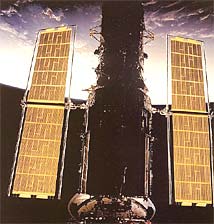
The Hubble Space Telescope, which searched for planets in the globular cluster 47 Tucanae
(image courtesy of NASA).
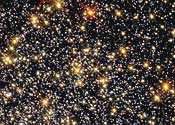
In 1999, astronomers searched for extrasolar planets with the Hubble Space Telescope by looking for planetary "shadows" passing in front of stars. No large, Jupiter-like planets were detected at that time in this globular cluster of 35,000 stars. Image courtesy of Hubble Space Telescope (STScI and NASA).
Research
In a study begun in 1988, astronomers had been timing the radio pulses from a pulsar, a collapsed supernova remnant (see Black Holes). The pulsar is located in our galaxy in a globular cluster, M4 (see image), which formed about 13 billion years ago. Precise timing of its pulses showed that the pulsar is wobbling, and that the companion is a white dwarf, a collapsed star about the size of Earth. Further study revealed a second companion, with less mass—either a small star or a planet.
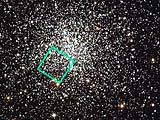
The globular cluster M4, consisting of about 100,000 stars, which formed within the first billion years of the Big Bang; the green rectangle shows the location of the newly-discovered planetary system. (image courtesy of NOAO/AURA/NSF)
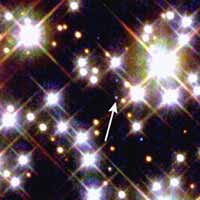
Hubble space telescope image of the white dwarf (indicated by the arrow), one of the two stellar remnants in the ancient planetary system in the globular cluster M4 (image courtesy of NASA/H Richter UBC).
Then a new team of investigators analyzed detailed images of this system taken by the Hubble Space Telescope in the 1990s. The Hubble cameras are so sensitive that they could detect this white dwarf, even though its brightness is about the equivalent of a 100 watt light bulb seen at the distance from Earth to the moon. Astronomers identified the white dwarf (see image), studied its spectrum, and deduced its mass. The result was that the second companion turned out to have a mass of 2.5 times Jupiter’s, so small that it had to be a planet, not a star.
This exotic system has a Jupiter-like planet in orbit around a pair of stellar remnants. The planet is several billion miles from these dead stars, about the distance of Uranus from the sun, and takes about a century to make one revolution. The artist’s conception shows the two central stars as seen from the vicinity of the planet.
Could this planet have supported life so early in the history of the universe? Probably not, because as a first-generation planet, it was composed of mostly hydrogen and helium and lacked carbon, nitrogen, sulfur, oxygen, and various other essential elements, at least for life as we know it. Also, this gas giant had no solid surface to provide an environment for large, advanced life forms like those on Earth.
Even so, the discovery of this new planet is exciting, because it shows that planets did indeed form early in the history of the universe. Now the planet-finders can investigate more stars in globular clusters for additional first-generation planets.
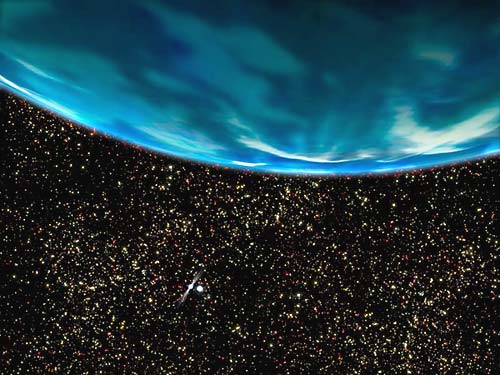
Artist’s conception of the Jupiter-like planet in orbit around a pulsar and a white dwarf in the globular cluster M4 (image courtesy of NASA).
Links
NASA
Hubble Space Telescope
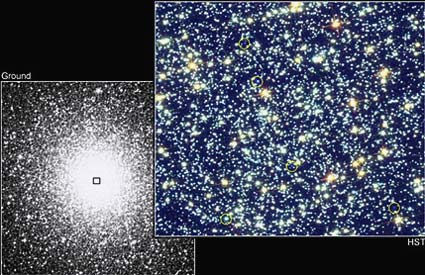
Two views of the globular cluster 74 Tucanae, one from a ground-based telescope and one from the Hubble. (image courtesy of NASA/H Richter UBC)














